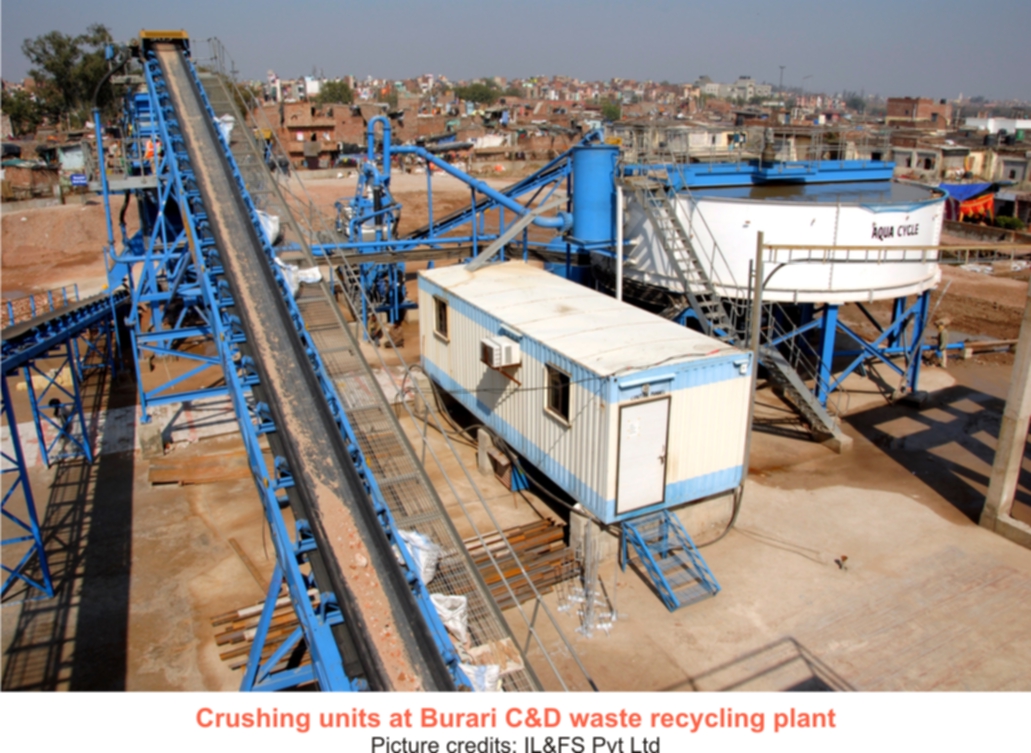|
Trash to Treasure – C&D Waste Recycling Story C onstruction and Demolition (C&D) waste recycling is still in its infant stage in India. However, its potential to be implemented on a large scale is pretty evident due to the present and projected infrastructure developments till 2020. The construction and demolition activities spurring out as a result of the growing economic activities generates huge amount of waste each year which is seen to be often disposed in landfills. In 2015, the urban C&D waste generation in India was estimated to be 716 million tonnes and is projected to increase to 2.7 billion tonnes per annum in 2041 (GIZ, 2016). The sensitisation of recycling C&D waste is slowly gaining momentum in the recent years due to the rising cost of materials (sand, stone and gravel) used for construction in addition to the labour and waste disposal costs. This scenario strongly favours the use of secondary raw materials which can be recovered from the waste stream and reused in all applicable areas across the sector.Construction and Demolition Waste Recycling Plant - Burari, New Delhi
The C&D waste processing plant was commissioned in 2010 and has been running successfully ever since. It is a perfect case study for green business models that could be replicated across Indian cities. The demolition waste is processed into finished products like paver blocks, kerb stones and other non-structural building materials which are certified by BIS, India to ensure quality manufacturing. The project is compliant with MSW, 2000 Rules and uses treated sewage water for washing of C&D waste. The treatment plant in Burari is the first of its kind in India. The successful operations in Burari has prompted the Delhi Municipal Corporation to commission three other recycling units, out of which a 500 TPD processing plant has already started operation in Shasthri park this year. Similar initiatives need to be undertaken by Urban Local Bodies (ULB) across the country to ensure the substitutability of recycled materials for new materials thus promoting resource efficiency in the Indian construction sector. Successful demonstration at the Burari site has proved how C&D waste can be utilised for constructive purposes while conserving precious natural resources. Based on this Initiative, Ministry of Urban Development (MoUD) has directed all states to setup such a facility in cities having population of above 10 lakhs. Policy Priorities National and state priorities at this stage should target towards the development of policies for proper C&D waste management systems which could minimise dumping and maximise recycling and reusing. Such policies on C&D waste should clearly mention who should handle waste, how should it be handled, how should it be processed and disposed. Enhancing resource efficiency should also focus on preferential procurement policies to support the application and use of resource efficient construction techniques and materials in the Indian construction sector. For example the Delhi government has implemented a policy that 5% of materials used in all government construction projects need to be of secondary raw materials. Facilitation of capacity building activities in the public and private sector could result in increased understanding on the utilisation of C&D waste which will allow a rapid industrial shift towards adopting resource efficiency. q References: • GIZ (2015), Resource
Efficiency in the Indian Construction Sector Market Evaluation of the
Use of Secondary Raw Materials from Construction and Demolition Waste. P Krishna Chandran |
 The
construction and demolition waste recycling plant in Delhi is installed,
operated and maintained on a Public Private Partnership basis between
the Delhi Municipal Corporation and Infrastructure Leasing and Financial
Services Private Limited (IL&FS Pvt Ltd).
The
construction and demolition waste recycling plant in Delhi is installed,
operated and maintained on a Public Private Partnership basis between
the Delhi Municipal Corporation and Infrastructure Leasing and Financial
Services Private Limited (IL&FS Pvt Ltd).